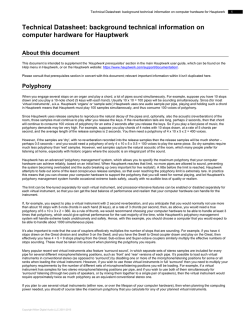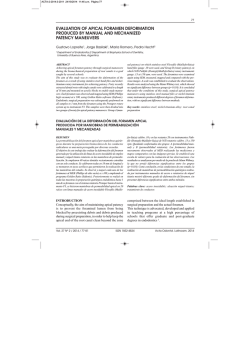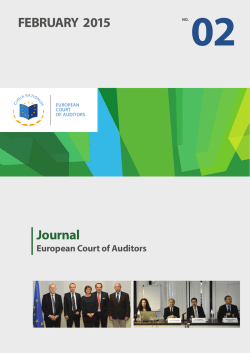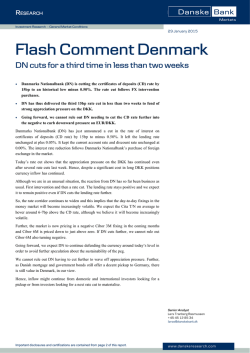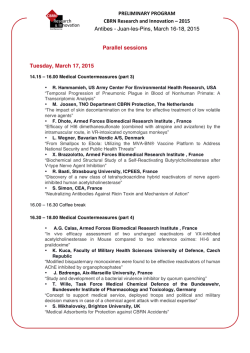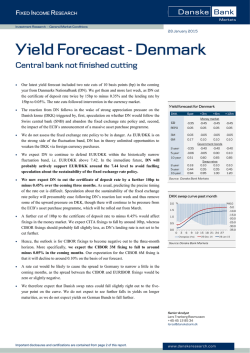
Self Study Series OSHA Regulatory Requirements
sELf-sTudy sERiE sELf-sTudy sERiEs Sponsored by OSHA Regulatory Requirements: February 2015 The self-study lesson on this central service topic was developed by 3M Health Care. The lessons are administered by KSR Publishing Inc. Earn CEUs The series can assist readers in maintaining their CS certification. After careful study of the lesson, complete the examination at the end of this section. Mail the complete examination and scoring fee to Healthcare Purchasing News for grading. We will notify you if you have a passing score of 70 percent or higher, and you will receive a certificate of completion within 30 days. Previous lessons are available on the Internet at www.hpnonline.com. Certification The CBSPD (Certification Board for Sterile Processing and Distribution) has pre-approved this in-service for one (1) contact hour for a period of five (5) years from the date of original publication. Successful completion of the lesson and post test must be documented by facility management and those records maintained by the individual until re-certification is required. DO NOT SEND LESSON OR TEST TO CBSPD. For additional information regarding certification contact CBSPD - 148 Main Street, Suite C-1, Lebanon, NJ 08833 • www.sterileprocessing.org. IAHCSMM (International Association of Healthcare Central Service Materiel Management) has pre-approved this in-service for 1.0 Continuing Education Credits for a period of three years, until January 6, 2018. The approval number for this lesson is hPN 150601. For more information, direct any questions to Healthcare Purchasing News (941) 927-9345, ext. 202. Learning Objectives 1. Discuss the importance of proper care and handling of contaminated instruments. 2. Describe scrub personnel’s responsibilities relating to the care and handling of instruments at the point of use. 3. Explain post-procedure steps required prior to transportation of contaminated items to the decontamination area. Instrument decontamination begins at the point of use by Rose E. Seavey MBA, BS, RN, CNOR, CRCST, CSPDT d espite increased emphasis in infection prevention efforts (e.g., enhanced sterilization methods, sterile barriers, and antimicrobial prophylaxis), surgical site infections (SSIs) remain a considerable basis of morbidity and mortality among patients.1 One consideration for prevention of SSIs is post-procedure handling of contaminated instruments. There are many procedures involved in the care and handling of contaminated instruments, however there are none more important than those at the point of use, where decontamination should begin. This article will focus on the perioperative responsibilities for surgical instruments at the point of use. Understanding and following current standards and guidelines helps to ensure patient safety and facilitates compliance with the Occupational Safety and Health Administration (OSHA) regulations in limiting occupational exposure to bloodborne pathogens and minimizing the risk of infection. Protect patients and employees A primary focus of the perioperative team, which of course includes Sterile Processing, is to protect patients as well as healthcare practitioners from transmissible infections.1 One of the risks for all health personnel is occupational exposure to bloodborne pathogens. The perioperative team has a potential for increased risk of this work-related hazard due to the nature of the procedures performed, the potential for blood exposure, and use of sharp devices.2, 3 One of the most frequent recommendations I make as a consultant is the need to improve the care and handling of contaminated surgical instruments at the point of use. More often than not, I see instruments coming to decontam covered in blood and tissue, delicate and sharp instruments unprotected and solutions in open containers. Healthcare facilities should develop policies and procedures built on current standards and guidelines that lead to best practices in helping to ensure safe practices for patients and employees. Following best practices can also lead to prolonged life of some of the facility’s most expensive resources, surgical instruments and equipment. Current standards and guidelines The Association of periOperative Registered Nurses (AORN) recently updated the guidelines (formerly called recommended practices) for Cleaning and Care of Surgical Instruments. These current evidence based guidelines are very comprehensive and intended to help healthcare facilities reduce the incidence of SSIs and protect healthcare workers as they care for and handle surgical tools. The Associations for the Advancement of Medical Instrumentation (AAMI) Comprehensive guide to steam sterilization and sterility assurance in health care facilities ST79:2010 & A1:2010 & A2:2011 & A3:2012 & A4:2013 also discusses procedures and rationales for care and handling of instruments at the point of use in sections six and seven. During the procedure Sponsored by: Instruments transported in biohazard solution and not contained in closed leak-proof container marked as biohazard. 36 February 2015 • HEALTHCARE PuRCHAsing nEWs • www.hpnonline.com Decontamination of instruments begins at the procedure site. Both AORN and AAMI recommend moistening and keeping instruments wiped down at the point of use. Throughout the surgical procedure, the scrub person- Self-study series Sponsored by Instruments not wiped down at point of use and not kept moist for transportation nel should keep instruments and equipment free of gross soil. If allowed to dry on surgical instruments, blood, organic material, debris, and saline can result in corrosion, rusting, and pitting. 2,3 Keeping instruments free of gross soil can be accomplished by wiping the surfaces with a sterile surgical sponge moistened with sterile water. Large items (e.g., orthopedic broaches) or instruments that tend to hold a lot of bioburden (e.g., acetabular reamers) may require a basin in a ring stand filled with sterile water in order to wipe away the gross soil. Saline is corrosive and should not be used to clean instruments. Discourage biofilm formation When blood or other bioburden dries it can cause the formation of biofilm. Biofilm is a buildup of bacterial and extracellular material that can quickly start to form on instruments if they are not kept free of gross bioburden. If left to dry, blood and other bioburden can make cleaning more difficult and can affect the efficacy of disinfection and sterilization.2,3 Biofilms protect microorganisms and make them harder to be removed with regular cleaning processes used in the sterile processing area. “Once biofilm forms, direct friction and/or oxidizing chemicals are needed to remove it.”2 Therefore, it is extremely important the perioperative team take measures to remove gross soil as soon as possible in order to reduce or eliminate the population of biofilm-forming microorganisms and thus prevent the formation of biofilm.2 Keep lumens clear The formation of biofilm can happen on many surfaces, however if it forms inside a lumen it is particularly challenging because it is very difficult to see and remove. Throughout the procedure scrub personnel should frequently irrigate lumens with sterile water Instruments transported without being in a closed container marked as biohazard (not saline). This can be accomplished by having a basin or pitcher with sterile water and periodically suctioning the water through the lumen or using a syringe to irrigate it. The smaller the lumen the more important it is to keep it clear. Expedite turnaround time Organic material and debris are more difficult to remove from surgical instruments if allowed to dry. The efficacy and effectiveness of cleaning and decontamination is improved when scrub personnel remove gross bioburden at the point of use both on surfaces and inside lumens. In addition to discouraging the formation of biofilm, removing gross bioburden at the point of use can help expedite the turnaround time for instrument sets. This is extremely important when the instrument sets are needed for subsequent procedures in the same day. Protect sharps OSHA’s bloodborne pathogens standard requires the safe disposal of contaminated sharps in order to decrease the risk of bloodborne pathogen transmission.4 All members of the perioperative team should contribute to sharps injury prevention. Scrub personnel are responsible for confining sharps (e.g., needles, scalpel blades) on the sterile field until the patient is out of the room. During the procedure, sharps/needle counter devices should be used to contain and isolate sharps on the sterile back table.5 Contaminated disposable sharps must be removed and disposed of in a closeable, puncture-resistant container that is leak-proof and is labeled or color-coded as biohazard.2,3 Post procedure Part of the scrub personnel’s responsibility after the procedure is to prepare the instruments for transportation to the decontamina- tion area. This includes separation of waste, linen and reusable items; segregating and protecting sharp instruments; disassembling multipart instruments; protecting delicate items; arranging instruments in an orderly fashion, and maintaining instrument sets together. Separate waste, linen and reusable items At the point of use, reusable instruments and equipment should be separated from waste (e.g., wrappers, drapes, disposable instruments, etc.) and reusable linen. Separation at the point of use minimizes handling by other staff and therefore decreases the potential for injury or exposure to hazardous material. Contaminated disposable items should be placed in an appropriate container according to OSHA regulations. Disposable items contaminated with blood, body fluids or tissue must be placed in a leak-proof container marked as biohazard before transport from the point of use.2,3,4 Segregate sharp instruments According to OSHA regulations, reusable instruments that are sharp (e.g., skin hooks, trocars, osteotomes, etc.) must be segregated from other instruments and confined in a puncture-resistant container at the point of use. OSHA forbids procedures that require personnel to reach their hands into containers that have sharp instruments in them due to the risk of percutaneous exposure to bloodborne pathogens.4 Protect delicate items Easily damaged and delicate instruments (e.g., fiberoptic cords, endoscopes, and microsurgical instruments) should be protected from damage. Delicate items should be placed above heavier instruments and equipment or placed into separate containers See self-study series on page 38 Self-Study Test Answers: 1. A, 2. B, 3. A, 4. B, 5. A, 6. B, 7. A, 8. B, 9. B , 10. A www.hpnonline.com • HEALTHCARE Purchasing NEWS • February 2015 37 Self-study series because instrumentation may shift during transport. 2,3 Disassemble multipart instruments Instruments and other items composed of more than one part (e.g., laparoscopic instruments, trumpet valves, dental handpieces, etc.) should be disassembled at the point of use, according to the manufacturer’s written instructions for use (IFU).3 Disassembling instruments helps to discourage the retention of organic material and debris on surfaces that otherwise may not be contacted by cleaning solutions, disinfection or sterilization processes. Arrange instruments Instrument preparation and logically arranging instruments at the point of use can help reduce damage to instruments. Instrument sets should be kept together and not mixed with other sets/trays. Disassembled instrument components (stopcocks, trocars, depth gauge, etc.) should be kept together in order to help ensure correct reassembly. Items should be kept organized for safety reasons and to discourage instrument loss or misplacement. All instruments on the sterile field should be considered contaminated whether or not they have been used. Instrument contamination on the field may occur without the incidence being noticed. Unused instruments may have been touched by scrubbed personnel without them being aware of it. Instruments may also come in contact with airborne microorganisms.3 Items needing repair or sharpening should be identified or tagged at the point of use for easy identification. This will allow SPD staff to segregate them during decontamination, reducing the risk that they’ll be returned for use without the necessary repair being done.2 Keep instruments moist Instruments should be kept moist until they are cleaned in order to help prevent bioburden from drying and adhering to the instruments making cleaning more difficult and increasing the potential of biofilm formation. The scrub personnel should keep instruments moist until they are cleaned. This can be accomplished by placing a towel moistened with water (not saline) over the instruments, using an instrument treatment such as an enzymatic or disinfectant spray, foam or gel, or placing the instruments inside a container designed to maintain humid conditions.2,3 Contain during transportation OSHA regulations require soiled instruments to be contained during transport to Sponsored by the decontamination area. Contaminated instruments must be transported in a closed container or enclosed cart that is leak proof, puncture resistant, large enough to contain all of the contents, and labeled with a biohazard label. 3,4 Care should be taken to avoid contamination of the outside of the instrument containment device. If the transport containment device is contaminated, it needs to be cleaned at the point of use or placed within another clean containment device which is labeled as biohazard.3 A red bag or red container may be used instead of a label to indicate contaminated waste if it is suitable to the configuration of the contents.3,4 Osha fines hospital Last year a hospital in the Northeast faced a $28,000 fine for violations of the bloodborne pathogen standard after they received a complaint about unsafe practices relating to contaminated instruments.6 The OSHA report cited several serious concerns including: •Potential for staff exposure to biohazards and sharps injuries due to: oSurgical instruments not wiped down after use, o Surgical instruments not disassembled, oDisposable blades not removed from reusable surgical instruments prior to transportation, o Contaminated instruments transported in open or loosely covered basins, oTransportation carts leaked contaminated fluids during transportation. Conclusion Procedures for handling contaminated instruments must be created to protect personnel, patients, and the environment from contamination and to comply with OSHA regulations limiting occupational exposure to bloodborne pathogens. Current standards and guidelines should be used to develop policies and procedures that define authority and responsibility for instruments at the point of use. Conducting periodic process audits on how instruments are delivered to the decontamination area may help ensure correct procedures are being followed. Developing and following a checklist for contaminated instrument transportation (see Example 1) may help with compliance. As a scrub tech, I was taught that we have as much responsibility for instrument safety as we do for patient safety. hpn References: 1. Recommended Practices for Prevention of Transmissible Infections in the Perioperative Practice Setting. In: Perioperative Standards and 38 February 2015 • HEALTHCARE Purchasing NEWS • www.hpnonline.com Contaminated Instrument Transportation Checklist •Instrument wiped of gross bioburden and lumens irrigated •Sharps separated and placed in a puncture resistant container •Multipart instruments disassembled and kept together •Delicate instruments and sharps protected •Instrument sets kept together •Linen, waste and disposable instruments separated from reusable instruments •Solutions disposed of prior to transportation •Contaminated items placed in closed containers •Containers marked as biohazard Example 1 Recommended Practices. Denver, CO: AORN, Inc. 2014, p385-417. 2. Association for the Advancement of Medical Instrumentation. Comprehensive guide to steam sterilization and sterility assurance in health care facilities, ANSI/AAMI ST79:2010 & A1:2010 & A2:2011 & A3:2012 & A4:2013 (Consolidated Text). 3. Recommended Practices for Cleaning and Care of Surgical Instruments. In: Perioperative Standards and Recommended Practices. Denver, CO: AORN 2014, e106-e140. 4. 29 CFR 1910.1030. Occupational exposure. Bloodborne pathogens. 2009. http://www.gpo.gov/fdsys/ pkg/CFR-2011-title29vol6/pdf/CFR-2011-title29-vol6- sec1910-1030.pdf. Accessed November 1, 2014. 5. Recommended Practices for Sharps Safety. In: Perioperative Standards and Recommended Practices. Denver, CO: AORN, Inc. 2014, p351-374. 6.United States Department of Labor. Occupational Health and Safety Administration. Inspection 974812.015 - Hallmark Health - Melrose Wakefield Hospital. https://www.osha.gov/pls/ imis/establishment.inspection_detail?id=974812.015. Accessed December 13, 2014. Ms. Seavey is an Educational Consultant to 3M Healthcare, Infection Prevention Division. Rose Seavey is President/CEO of Seavey Healthcare Consulting. Seavey served on the AORN Board in 2008-2010 and was President of ASHCSP in 2003. She received numerous awards such as AORN’s award for Mentorship in 2012 and Outstanding Achievement in Nurse Education in 2001. In addition, she received the national 2013 IAHCSMM award of Honor, the Industry Leadership Award from the Massachusetts chapter and the educator of the year award from the Golden West chapter. Seavey was one of the Who’s Who in Infection Prevention in 2006 by Infection Control Today. Ms. Seavey is widely published in professional journals and is the author of the book titled Sterile Processing in Healthcare Facilities: Preparing for Accreditations Surveys, published by AAMI and she serves on several AAMI committees writing standards. Ms Seavey is also a valued member the the HPN advisotry board. Self-study series Sponsored by Continuing education test • February 2015 OSHA Regulatory Requirements: Instrument decontamination begins at the point of use Circle the one correct answer: 1. Exposure to bloodborne pathogens is an occupational risk for all healthcare workers. a.True b.False 2. Instrument decontamination begins when they arrive in the decontamination area. a.True b.False 6. Saline should be used to clean instrument surfaces. a.True b.False 7. During the procedure, sharps/needle counter devices should be used to contain and isolate sharps on the sterile back table. a.True b.False 8.Reusable instruments and equipment should be separated from waste (e.g., wrappers, drapes, disposable instruments, etc.) after transportation to the decontamination area. a.True b.False 3. Instruments should be kept free of gross soil during the procedure. a.True b.False 4. The formation of biofilm makes instruments easier to clean. a.True b.False 5. The efficacy and effectiveness of cleaning and decontamination is improved when the scrub person removes gross bioburden at the point of use both on surfaces and inside lumens. a. True b. False 9. Instruments placed on the sterile field but not used do not need to be decontaminated. a.True b.False 10.Items needing repair or sharpening should be identified or tagged before being transported to the decontamination area. a.True b.False Continuing education test • February 2015 Presented by Sponsored by The approval number for this lesson is HPN 150601. Request for Scoring o I have enclosed the scoring fee of $10 for EACH test taken. (Payable to KSR Publishing Inc. We regret that no refunds can be given. Multiple submissions may be submitted in bulk and paid with a single check for the bulk sum.) Detach exam and return to: Continuing Education Division KSR Publishing Inc. 2477 Stickney Point Road, Suite 315B Sarasota, FL 34231 PH: 941-927-9345 Fax: 941-927-9588 Please print or type. Return this page only. Name Title Hospital Name Mailing Address Apt/Suite City, State, Zip Daytime Phone E-mail www.hpnonline.com • HEALTHCARE Purchasing NEWS • February 2015 39
© Copyright 2026

